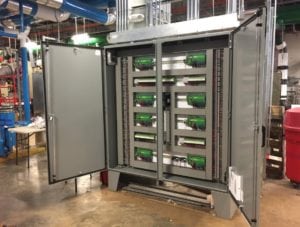Buildings Are Smarter Than Ever: Trends in Smart Building Systems
The Internet of Things is expanding into every aspect of infrastructure, putting greater demands on the sensors and connectors that keep these systems on constant guard.
Electricity was just the beginning. Today’s built environment has integrated technology into every aspect of the form and function of buildings of every type. Our homes, schools, office buildings, public spaces, and manufacturing facilities are increasingly connected to a constellation of automated systems that control everything from climate control and security to energy usage monitoring or even energy generation. These systems rely on a network that includes sensors to monitor conditions and activate smart systems. Connectors play a key role in conveying this information. We talked to Haroon Rashid, infrastructure vertical market manager at Phoenix Contact, to learn about the latest trends in smart buildings systems.
Trends in Smart Building Systems

Haroon Rashid, infrastructure vertical market manager at Phoenix Contact
Lighting, HVAC, and security systems have been integrated into smart buildings for a while now. What do the latest smart building systems control or monitor?
When considering the building automation business, the first sub-segment or application that comes to mind is the HVAC system. Some may think that HVAC is the largest area of application in a building automation system, but this is no longer true. Security and operations applications have long surpassed the HVAC systems as the largest system in a building automation project. In order of size, these are the most important building automation applications today: security and operations, fire protection, HVAC, and lighting. The latest smart buildings have even more automated applications. Microgrid, local pumping stations, and energy management are also significant areas. With the electric vehicles becoming more common, EV charging stations will also become part of smart buildings.
What control systems are used for smart buildings?
Several communication protocols are used for control and monitoring, such as BACnet and Modbus, both in serial and IP versions. The edge devices are generally on a serial communication protocol in order to save costs, but in a smart building, the edge devices are integrated with the servers to achieve optimum efficiency from a system. New guidelines to build Net Zero energy buildings are being implemented as well. This will increase the number of applications around microgrid and solar power management control and monitoring.
How do industrial spaces utilize these technologies?

Phoenix Contact worked with OTI on an upgrade project at a large, state-of-the-art data center. OTI connected 12,000 I/O points from control systems in the first 10,000-square-foot data hall plus office space and chiller plant. (Photo courtesy of OTI)
Historically, in an industrial organization, the industrial applications and building automation applications have been managed by different departments. The reason was that innovation in building automation technologies has been fairly isolated from the innovations in the factory automation. The communication protocols, the Supervisory Control and Data Acquisition (SCADA) applications, the manufacturing executive systems (MES), have all taken their own direction independent of each other. Only recently, and only in some industrial organizations, have the building automation and factory automation teams gotten together to identify synergies, improve efficiencies, and save costs through shared solutions. Due to the technology advancements in both areas, it may be a little while before any significant collaborative solutions can be developed jointly for building and industrial spaces.
How is the connected buildings trend impacting the connector and sensor world?
Connected sensors, also known as edge devices, are at the heart of the Internet of Things (IoT). That means we integrate data from a remote sensor into the main server and control system. Until now, the edge devices have been providing inputs for independent controls. The communication from remote sensors to the control room is making it possible for the building managers to monitor failures, run analytics, refine processes, and make the operations more efficient. The challenge is that all the data being generated and communicated to the control room needs to be transferred securely, analyzed, and utilized efficiently.
Are there any developments towards standardization that impact hardware for this market?
Yes. Several manufacturers and OEMs are developing solutions along these lines, although that’s a much longer discussion for another time.
Are fiber optics playing a bigger role in these systems?
Yes, and so are copper and wireless technologies. Each has its own significance.
Is there a hardware solution for concerns about data security or cyber attacks on smart buildings?
Phoenix Contact’s FL mGuard family of rugged security devices includes firewall, routing, and optional VPN functionality to protect critical networks. These high-level “Layer 3” functions can protect networks from attacks and accidental interruption while connecting to office or enterprise networks.
What other challenges are expected as IoT expands into infrastructure?
The biggest challenge for the foreseeable future will be how to keep the data secure and how to use it efficiently. Generating data is not a problem; industry has been generating data since the 1970s. The data usage has been growing exponentially every decade since. The IoT challenge is that there is so much data being generated by the edge devices, in multiple formats, that it is hard to analyze and maintain the integrity of this data.
Interested in a specific market? Click a market below for current articles and news.
Automotive, Consumer, Industrial, Medical, Mil/Aero, Datacom/Telecom, and Transportation
- Meet the Connector: DIN Standard Connectors - April 16, 2024
- Software-Driven Radio Reinvigorates Old Technology - April 9, 2024
- What is a Busbar? - April 2, 2024












